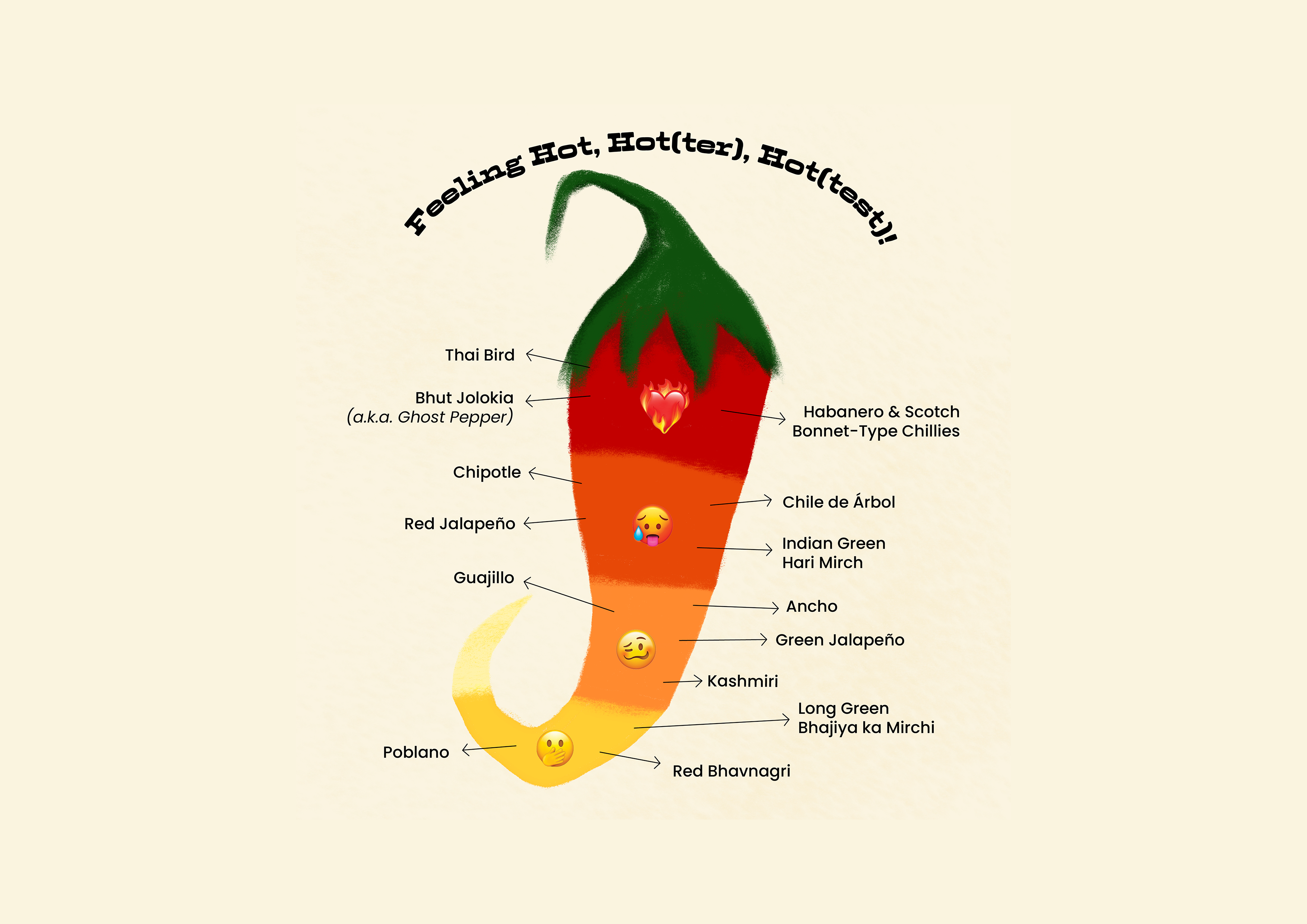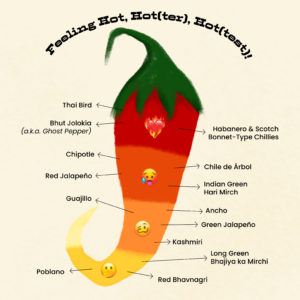Without chillies, there is no hot sauce. These naughty little fruits contain a natural irritant that most animals are smart enough to stay away from, but one that we can’t get enough of, no matter how much it hurts. To our good fortune, that sweet, sweet pain turns into a mad rush of pleasure-giving endorphins, beckoning us for more. Chillies boast a wide spectrum of both heat levels and flavours, two important factors to consider when making hot sauce.
Green chillies have a grassy, vegetal quality that pairs well with fresh herbs. Meanwhile, red, yellow, and orange chillies taste fruity and ripe, a quality that makes them particularly well-suited to taking the center stage and standing on their own.
Not all chillies burn in quite the same way. Some, like the poblano chilli, are so mild they taste more like a bell pepper. These mild chillies work as supporting characters, but aren’t so effective on their own. While others, like the red Thai bird chilli, can be deceptively spicy for their size, punching way above their weight. Understanding the inherent qualities in the types of chillies you choose will free you to create the kind of hot sauce that fits you better than a Christmas sweater.
What follows is a quick reference guide to a few common chillies, many of which are called for in the recipes in this column, listed from mildest to hottest.
Note: In India, we are blessed with a wide assortment of chillies, from fresh to dried. While the chillies I mention may be some of the most commonly available, I encourage you to use any chilli you like and adapt the recipes to suit your own tastes.

Fresh Chillies: Green
Long Green Bhajiya ka Mirchi
This mild chilli can be eaten as a vegetable and is often stuffed, battered, and fried. It has a pleasant flavor, ranging from slightly warm to medium-hot. These remind me of the Anaheim chillies I grew up on, but they aren’t the same variety. They work very well when roasted and peeled before being made into hot sauce.
Poblano
Wider and shorter than the long green bhajiya ka mirchi, the poblano is dark green with a rich flavour. It resembles the green bell pepper, if only by appearance. It is one of the most commonly used chillies in Central Mexican cooking, both in its fresh and dried forms (see “Ancho” below). They are only slightly hot, and are usually roasted and peeled before use.
Jalapeño
The jalapeño is the classic hot pepper and one of the world’s best-known chillies, particularly in its pickled form where it is used everywhere from pizzas to martinis. The fresh jalapeño has a strong, vegetal flavor and a medium-to-spicy heat that is assertive but not chokingly so.
Indian Green Hari Mirch
Perhaps the most common fresh chilli in city markets, it is the workhorse of chillies and one of spiciest green chillies available. Their flavour is best appreciated when used in significant quantities which all but guarantees you’ll break a sweat.

Fresh Chillies: Red and Ripened
Red Bhavnagri Chilli
A handsome chilli with a gentle flavor, ranging from slightly warm to medium-hot, and a touch of sweetness. Think of it like a red bell pepper with a hint of spice. They are excellent pickled and even better when roasted over fire until black and blistered. The blackened skin can be peeled and discarded or pureed right into the hot sauce, imparting a wonderful smoky flavor.
Red Jalapeño
Like its unripe counterpart, the green jalapeño, the red jalapeño packs in some serious heat. But unlike the green variety, it also has a complex fruity, aromatic character that I find intoxicating. Fresh, roasted, pickled, fermented — it’s all good.
Thai Bird
Tiny, skinny, and pointy, Thai birds are the most common type of chilli grown in Thailand. They are very hot and used in large quantities in the spicy cuisines of Southeast Asia. I prefer these best in chunky condiments like the Tanzanian Pili Pili Sauce, where the flavour is best expressed after a few rounds in the mortar and pestle.
Habanero and Scotch Bonnet varieties
Named after Havana, Cuba, (“Habanero” means “someone from Havana”), the habanero and its close cousin, the Scotch bonnet, hail from the Caribbean where they are showcased in sauces like the famous Barbados pepper sauce and Jamaican jerk sauce. Unfairly, they have come to be known less for their delightfully fruity flavour and aroma, reminiscent of a ripe apricot or peach, and more for their intense spice.
True, they must be handled with care — you don’t want to touch your eyes (or any other body parts) after cooking with them — but they also have a delicious flavour that must not be overlooked.
Bhut Jolokia, a.k.a Ghost Pepper
Prized in the Northeast of India, particularly Assam and Nagaland, this is one of the spiciest chillies on earth. Like the habanero, it has become synonymous with the more painful aspects of eating chillies. It’s even been weaponised by the Indian military to flush terrorists-in-hiding from their caves. Caution: proceed at your own risk.

Dried Chillies
Note: Dried Chillies make excellent hot sauces. They have a concentrated, raisin-like quality that will give your hot sauce a distinct flavour. Do keep in mind that if you intend to make a fermented chilli hot sauce as in the Louisiana-style hot sauce, dried chillies do not work well for that particular method. In that case, it would be better to blend them into the hot sauce at a later stage, once the fermentation of the fresh chillies is complete.
Kashmiri
One of the most readily available dried chillies, the Kashmiri is best known for the stunning red colour it imparts into food. It has a gentle spice and a delicate flavour best enhanced through brief toasting, or frying in oil. Sometimes, I choose to use it as a colour enhancer to make my hot sauces even more attractive.
Ancho Chilli
The dried form of the fresh poblano chilli, it is dark brown and wide (the word ancho means “wide” in Spanish). It is the meatiest of the dried chillies, their flavour rounded and slightly bitter. They are most often mild, although occasionally one will slap you with a bit of heat.
Guajillo
The dried form of the fresh mirasol chilli, the guajillo is tapered with a smooth, shiny, reddish skin. It reminds me of the Kashmiri chilli by way of the reddish-orange colour it gives to food. But that is where the similarities end. The guajillo is mildly tangy, with medium-hot spice.
Chipotle
Ah, the chipotle. What a great chilli. It is the smoked and dried form of the fresh jalapeño. Small, wrinkled, and light brown, it has an incredibly rich, smoky flavor and is usually very hot. I quite like them in their canned avatar, packed in adobo sauce (tomato, vinegar, onions, and spices). The canned product lends itself well to hot sauce and is not only easy to use, but also very versatile.
Chile de Árbol
The chile de árbol (literally “tree chilli”) is a small, red, shiny chilli with a thin tapering body like a candle flame. It has a high heat level—in fact, it is one of the hottest dry chillies available—and is often chopped and simmered with other ingredients like tomatoes and onions to help mellow it out and soften the blow. In its fresh form, it resembles a fully mature Thai bird chilli.

This guide is part one of our three part Hot Sauce series curated by Chef Alex Sanchez. Read part two here.


